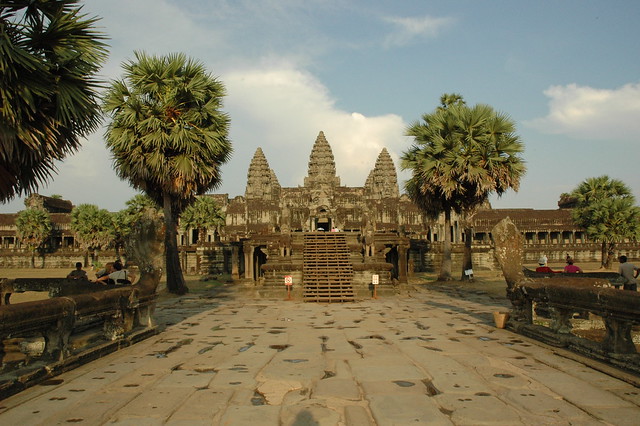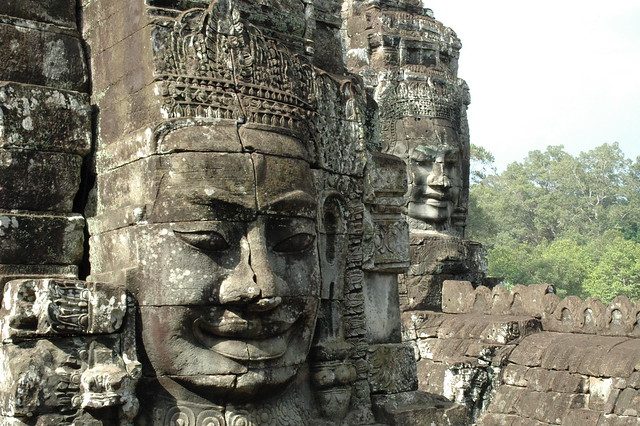For 800 years the temples and shrines of Angkor Wat
The temples at Angkor Wat, built in the early 12th century under the reign of King Suryavarman II, have been a center of religious worship continuously since its construction, making it the oldest site where religious activities have taken place uninterrupted.
Originally built as Suryavarman’s royal temple and center of the king’s court, Angkor Wat was constructed to honor the Hindu god, Vishnu. Angkor Wat was abandoned as the nation’s capital after it was attacked by an enemy clan within Cambodia at the time. A new capital was created and served as the royal center of power, leaving Angkor Wat to the local people who prayed in the temples that cover the 203 acres that comprise the whole of these magnificent structures built in the classic style of the Khmer.
In the 13th century, King Jayavarman VII was deposed by his son-in-law who had studied for 10 years in a Buddhist monastery and Cambodia quickly adopted Buddhism as the state religion. The Cambodian people were quick to accept this new religion that focused on the spiritual rather than material world. At this time, Angkor Wat became a shrine and a holy site for Buddhists throughout the region.
The original layout of the shrines and temples is clearly evident but construction at the site continued for almost four hundred years. As such, the complex is an architectural history showing change across four centuries – living history.
In that time, numerous buildings were added including decorative carved bas relief lines, many temple walls, representing the Hindu deities for which the temple was originally constructed. This centuries-long creation provides a trove of anthropologic information showing the evolution of the Cambodian culture and political structure. Even today, Angkor Wat continues to be one of the most researched sites on the planet. Its rich history is carved in the stone that makes up this mystical, awe-inspiring place.
The temples of Angkor Wat have remained sacred to the Theravada Buddhist sect into modern times and remain a place of great religious and spiritual power within the large segment of Buddhists that comprises the Cambodian population.
Over the centuries, the temples at Angkor Wat were gradually overtaken by the surrounding jungle and, in the early part of the 20th century, the site was in need of restoration. Recognizing the cultural significance of this remarkable series of shrines and spires, the world community came together to restore Angkor Wat to its former glory. Today, this holy place is not only a pilgrimage destination for Buddhists, it has become a major source of tourism revenue for Cambodia. The site is well-maintained and is, indeed, one of the wonders of architecture 800 years after work was begun.
The Significance of Design at the Site of Angkor Wat

Because Angkor Wat was built as a Hindu complex and center of state, the design of the complex is based on Hindu religious icons. The main temple is a representation of the home of Hindu gods, Mount Meru.
Surrounding the main temple are five spires that represent the five mountain peaks that surround Mount Meru. Angkor Wat was enclosed, the walls representing mountains. It was also surrounded by an immense moat, a representation of the sea. Thus, when the complex at Angkor Wat is taken as a whole, it becomes a representation of the world in miniature as it was known during the 1200s.
The walls of Angkor Wat are decorated, not only with bas relief depictions of Hindu deities, but also representations of the king and royal authority. However, archeologists suggest that many walls of the complex remain bare when work stopped on Angkor Wat upon the death of Suryavarman.
Many of these carved decorations depict known science at the time, particularly astronomical signs and symbols leading some anthropologists to suggest that Angkor Wat was more than a palace for Suryavarman and a private religious sanctuary for the king and his inner court.
Some anthropologists suggest that many of the bas reliefs that adorn the temple walls make a political statement as well as a religious one, pointing to a new era of learning, engagement and a contented populace, something that any monarch would desire.
The design and layout of Angkor Wat remain somewhat of a mystery. Khmer temples are built facing the east. The temples at Angkor Wat are oriented toward the west, the source of some controversy among the anthropology community. Some experts believe that the unusual alignment of the complex indicates that Angkor Wat was intended to serve as the burial site of its builder, Suryavarman.
Other anthropologists believe the alignment of Angkor Wat is more likely based on the deity to which it was originally constructed, Vishnu. In Hindu religious texts, Vishnu is associated with the west and, therefore, the western alignment of Angkor Wat makes sense despite its contrary positioning to other Cambodian temple sites.
Do the Features of Angkor Wat Suggest Engagement With Aztecs or Egyptians?

Using architecture and the advent of architectural innovation, anthropologists attempt to uncover connections between diverse cultures.
While there is no evidence to suggest that the design of Angkor Wat is imitative of the great pyramids of the Egyptians, Incans or Mayans, some within the anthropology community point to Angkor Wat as an example of cultural transference – the exchange of technology, linguistics and other elements that define diverse cultures.
Some experts point to the alignment question as an indicator that Angkor Wat was a Cambodian adaptation of either Egyptian or Mesoamerican civilizations. Others point to architectural innovations that appear in the design and construction of newer buildings over the 400-year span that construction was undertaken at Angkor Wat.
In fact, the buildings at Angkor Wat follow traditional building practices seen in other temple sites throughout the region. There’s no need to speculate how Cambodian architecture evolved. The evidence still stands, available for further study and analysis.
The Magic of Angkor Wat

However, this remarkable place is more than a collection of buildings. It is more than a site of archeological study. It is more than the cause for debate among anthropologists.
In today’s high-tech society, Angkor Wat stands as a true wonder. It has been described as mystical, magical and “almost surreal” – sentiments expressed by Westerners upon visiting the site for the first time. This is the true appeal of Angkor Wat.
Indeed, its history and construction are important to understand. However, it is the mysterious and the dynamic energy that emanates from this sacred spot that is the true story of this collection of holy buildings.
Angkor Wat is truly the world’s Temple of Time.
Also check out Lima’s article
Evolution of Culture, Genetic Anthropology, and the “Eve Theory”
For decades, anthropologists have debated “The Eve Theory” – the theory that world cultures migrated and evolved from a single source – Eve, a reference to Adam and Eve mentioned in the Bible’s Book of Genesis as the first man and woman and the progenitors of all human life.This article is contributed by Lima, an avid traveler who owns a website offering high quality adjustable dumbbells for sale
1st Photo © Adana Lima
Photo 2-4 © Cornstaruk







0 Comments:
Post a Comment
We appreciate comments, but we delete SPAM.